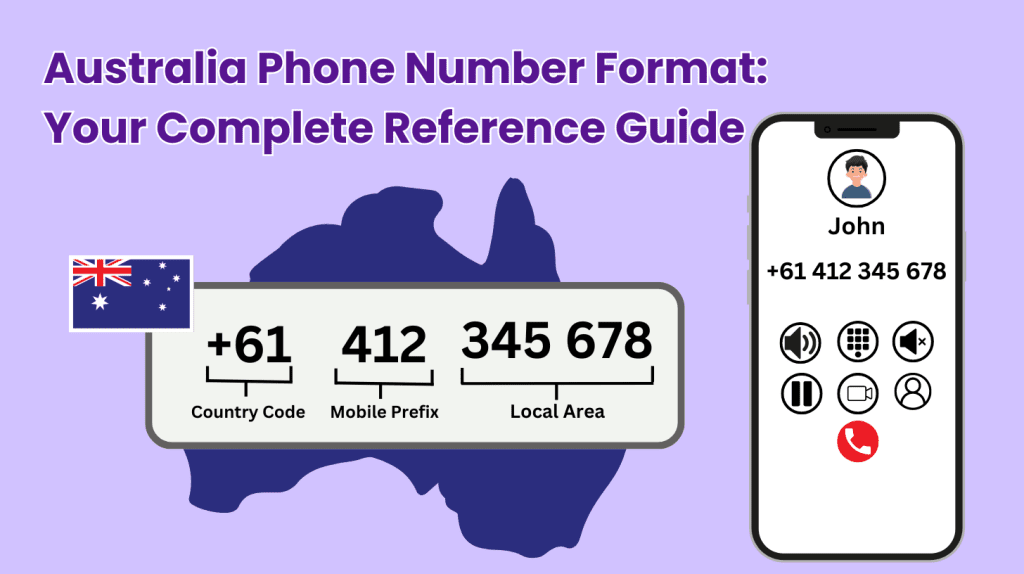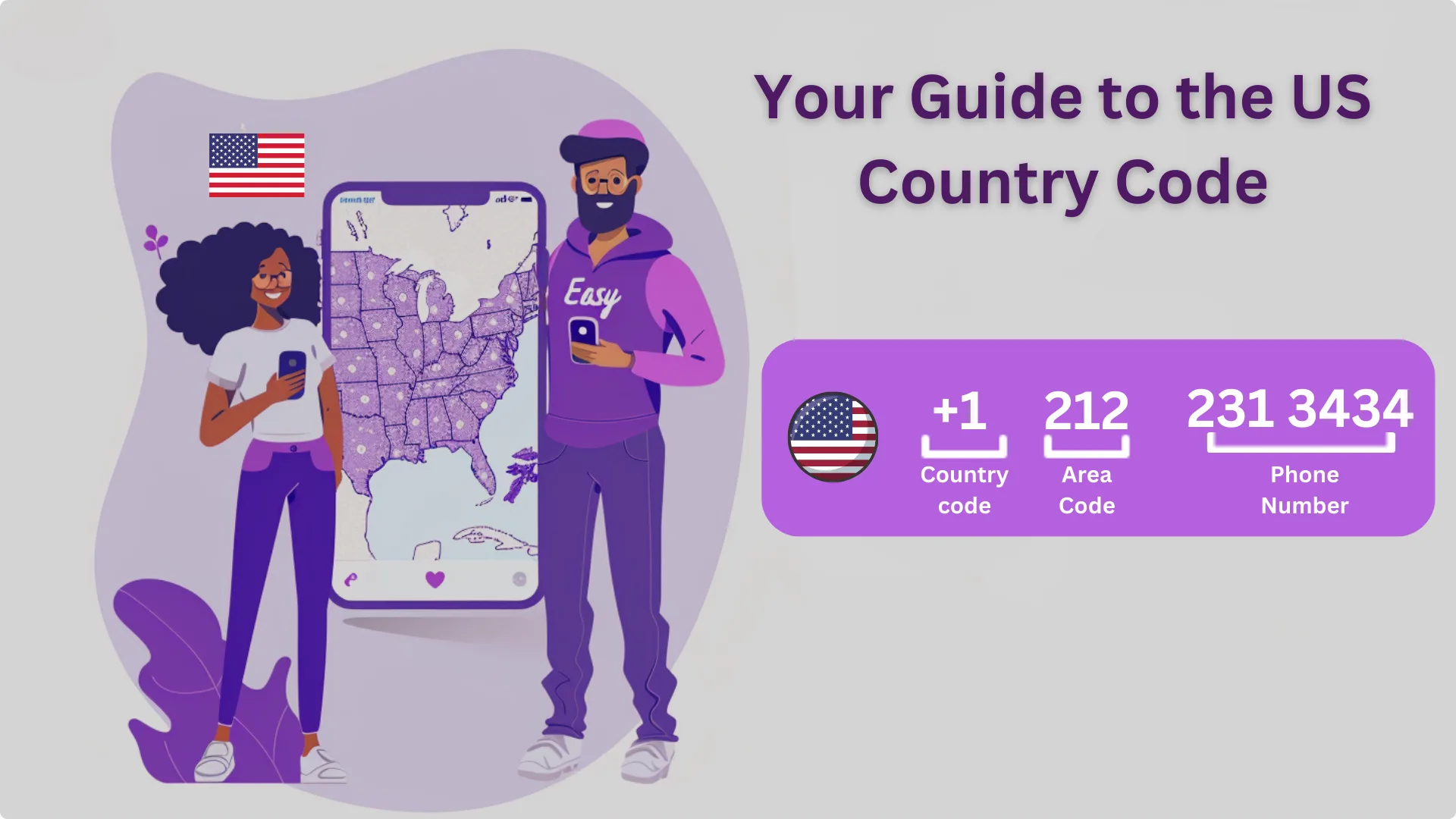Are you confused about how to dial a number in Australia? Look no further! This comprehensive guide will provide you with all the information you need to understand Australian phone number formats.
From the trunk prefix to area codes, landlines to mobiles, international dialing, and common mistakes to avoid, this article has got you covered.
Stay tuned for additional tips on dialing Australian phone numbers efficiently. Let’s simplify the process together!
Key Takeaways:
- Know the format for Australian phone numbers, including the trunk prefix and area code, to avoid confusion when making calls.
- Remember to use the correct international dialing code when calling from Australia, and double check for common mistakes to ensure successful calls.
- Efficiently dial Australian phone numbers by following tips such as saving contacts with the country code, using the + symbol, and omitting the trunk prefix when calling within the same area.
Australian Phone Number Format: An Overview

Understanding the Australian phone number format is crucial for both residents and visitors in Australia, as it ensures efficient communication across the country. Australian phone numbers are structured in a specific format that includes a country code, area code, and a subscriber number. For an Australian mobile phone number, the structure includes the country code (+61), followed by a mobile code (4), and then the subscriber number. Whether you’re dialing a landline or a mobile number, knowing the correct format can help avoid common mistakes and ensure your call is connected successfully.
What is a Trunk Prefix in Australia?
In Australia, the trunk prefix is an essential component of the phone number format that facilitates long-distance calls within the country. The text is already contained within
tags, so no further formatting is needed.
How to Use the Trunk Prefix in Australian Phone Numbers?
To use the trunk prefix in Australian phone numbers, you need to dial the prefix followed by the area code and the subscriber number.
When dialing from within Australia, the trunk prefix is usually ‘0’. For instance, if you are calling a landline in Sydney with the area code 02 and the number 1234 5678, you would dial 02 1234 5678 after the ‘0’ trunk prefix.
If you are calling internationally to an Australian number, the process is a bit different. In this case, you would dial the international dialing code (e.g., +61 for Australia), then the ‘0’ trunk prefix, followed by the area code and the subscriber number.
Remember, always ensure you have the correct country and area codes handy when making international calls to Australia to avoid any dialing errors.
What is the Area Code in Australia?
The area code in Australia is a crucial part of the phone number format that indicates the specific geographical region or city. When making international calls to Australian landline numbers, the Australian telephone number is directed based on the country code, area code, and subscriber number to ensure it reaches the intended destination.
These area codes play a vital role in helping callers identify the location of the person they are trying to reach within Australia. For instance, the area code ‘02′ is commonly associated with Sydney, the largest city in Australia, known for its iconic landmarks like the Sydney Opera House. Melbourne, another major Australian city, uses the area code ‘03′. Brisbane, famous for its sunny weather and vibrant cultural scene, has the area code ‘07′.
By having distinct area codes assigned to different regions, Australians and international callers alike can easily recognize and dial the correct phone numbers for specific areas, making communication more efficient.
How to Determine the Area Code in Australian Phone Numbers?
To determine the area code in Australian phone numbers, you can refer to a comprehensive list of area codes assigned to different regions and cities.
For instance, when looking up the area code for Sydney, you can easily find it by searching online or consulting a telecommunications directory specific to Australia. A popular tool for finding area codes in Australia is the Telecommunications Numbering Plan (TNP), which is maintained by the Australian Communications and Media Authority (ACMA). Similarly, if you need the area code for Melbourne or Brisbane, you can also utilize online resources like the official ACMA website or telecommunications providers’ websites.
What is the Format for Australian Landline Numbers?

The format for Australian landline numbers includes the area code, followed by the subscriber number, and often begins with a trunk prefix when dialing long-distance. An Australian phone number example would be +61 3 XXXX XXXX, where ‘+61’ is the country code for Australia, ‘3’ is the area code for Melbourne, and ‘XXXX XXXX’ is the subscriber number.
When calling within the same area, the area code may not need to be dialed after the initial connection. For instance, a typical landline number in Melbourne might look like 03 XXXX XXXX, with ‘03′ being the area code. In contrast, when calling from Sydney to Melbourne, the full national dialing format would be required, such as 03 XXXX XXXX. It’s important to note that telephone numbers can vary by region, with some areas having shorter or longer subscriber numbers.
How to Dial a Landline Number in Australia?
To dial a landline number in Australia, you first need to enter the trunk prefix ‘0′, followed by the area code and the subscriber number.
Once you have the landline number you wish to dial, simply pick up the phone and start by pressing the key ‘0′, which serves as the trunk prefix. Then proceed by entering the specific area code for the region you are calling. South Australia uses area code 8, while Victoria and Tasmania share code 3. It’s essential to double-check the area code as these can vary across different territories.
After inputting the correct area code, finish off the process by typing in the subscriber number of the landline you are trying to reach. For example, a typical landline number in Melbourne might look like 03 9xxx xxxx, where 03 is the area code. Once all these steps are sequentially completed, you should hear ringing on the other end of the line!
What is the Format for Australian Mobile Numbers?
Australian mobile phone numbers typically start with a mobile prefix ‘04′ and are followed by the subscriber number, ensuring a standardized format across the country.
In Australia, mobile phone numbers are structured with a clear format for easy identification. The mobile prefix ‘04′ signifies that the following digits belong to a mobile phone. The subscriber number that comes after the prefix is usually 8 digits long. For example, a valid Australian mobile phone number could be ‘04XX XXX XXX’, with ‘XX’ representing various digits. It’s important to note that the mobile prefix is not interchangeable with landline numbers or international codes, maintaining clarity in communication.
How to Dial a Mobile Number in Australia?
To dial a mobile number in Australia, you start with the mobile prefix ‘04′, followed by the remaining eight digits of the subscriber number.
Once you have dialed the mobile prefix ‘04′, make sure to include the area code if you are calling a landline number. For example, if you are calling a landline in Sydney, you would add the area code ‘02′ before the eight-digit subscriber number. This applies to most major cities in Australia, each with its specific area code.
Remember that when making international calls from Australia, you need to add the country code before the number. For instance, if you are calling a number in the United States, you would dial ‘001′ followed by the full number.
How to Dial an International Number from Australia?

Dialing an international call from Australia involves using the exit code ‘0011′, followed by the country code of the destination, and then the phone number. Understanding the correct procedure for making an international call is crucial for ensuring successful connections, especially in business contexts.
What is the International Dialing Code for Australia?
The international dialing code for Australia is ‘61′, which is used when making calls to Australian numbers from abroad.
When dialing an international number to reach Australia from another country, you would typically start by entering the international access code of the country you are dialing from, followed by ‘61′ for Australia. This code helps direct the call to the Australian telecommunications network. Then, you would input the area code for the specific region in Australia you are calling, and finally, the local phone number. Combining these elements in the correct sequence ensures that your call reaches the desired Australian phone number without delays or errors.
Understanding International Dialing Codes for Australians
To dial an international number from Australia, you start with the exit code ‘0011′, followed by the country code and the subscriber number of the destination.
For example, if you were to call the United States, you would dial ‘0011′, then the US country code ‘1′, followed by the area code and local number. Remember, when dialing European countries, you start with ‘0011′ as usual, then the European country code – say, ‘44′ for the UK, before entering the rest of the phone number.
When reaching countries in the Asia-Pacific region, dial ‘0011′ followed by the relevant country code – like ‘86′ for China – and lastly, the recipient’s phone number. It’s important to ensure the correct sequence of dialing codes to avoid any connection issues.
What is the Format for Dialing International Numbers from Australia?
The format for dialing international numbers from Australia includes the exit code ‘0011′, the country code, and the international phone number of the recipient. When writing phone numbers in international format, start with the plus sign ‘+’ followed by the country code (such as ’61’ for Australia) and omit the leading ‘0’ from the phone number.
To dial an international number from Australia, you typically start with the exit code ‘0011′ followed by the specific country code for the destination you are calling. For instance, if you were dialing a number in the United States, the country code would be ‘1′. After entering these codes, you proceed with the actual phone number of the recipient, making sure to include any area or city codes. Remember to drop the leading ‘0′ from the international phone number if the destination country omits it.
Common Mistakes When Dialing Australian Phone Numbers
When dialing Australian phone numbers, common mistakes can include omitting the trunk prefix, using incorrect area codes, or misunderstanding the mobile prefix format.
What are the Common Mistakes to Avoid when Dialing Australian Phone Numbers?
Common mistakes to avoid when dialing Australian phone numbers include forgetting to use the trunk prefix ‘0′ for long-distance calls and confusing landline area codes with mobile prefixes.
Another common error is failing to include the country code ‘+61′, as it is essential for international calls. For instance, dialing a Sydney landline would require the sequence +61 2 (Sydney area code) followed by the specific number. Overlooking the need to add the ‘04′ mobile prefix for cellular calls can cause connection issues. To ensure accurate dialing, take note of the correct sequence and adhere to it consistently. Utilizing the right prefixes and codes is crucial for effective phone communication.
Additional Tips for Dialing Australian Phone Numbers

To dial Australian phone numbers efficiently, it’s useful to remember specific tips such as verifying the area code, using the correct trunk prefix, and double-checking the mobile prefix.
What are Some Tips for Dialing Australian Phone Numbers Efficiently?
Some tips for dialing Australian phone numbers efficiently include always using the correct trunk prefix, familiarizing yourself with area codes, and ensuring the mobile prefix ‘04′ is correctly used.
Another crucial tip is to remember to use the correct country code when dialing international numbers from Australia. For example, when calling the United States, use the country code +1 before the area code and phone number. Consider using online directories or smartphone apps that provide up-to-date information on Australian phone numbers to avoid any errors. It’s also important to double-check the digits before making the call to ensure accuracy and avoid misdialing which can waste time and cause frustration.
Voicemail and Message Services in Australia
Accessing Voicemail
- Most Australian mobile phone carriers offer voicemail services as a standard feature.
- To access voicemail, dial a specific number provided by your carrier (usually 101 or 1 voicemail).
- You’ll typically need to set a PIN for voicemail security upon first use.
Voicemail Features
- Voicemail allows callers to leave a message when you can’t answer your phone.
- You can listen to, save, delete, or forward voicemail messages remotely.
- Some carriers offer voicemail transcription, allowing you to read the message text instead of just listening.
Message Services
- Short Message Service (SMS) is widely used in Australia for text messaging.
- Multimedia Messaging Service (MMS) allows sending multimedia content like pictures and videos through text messages.
- Voice over LTE (VoLTE) enables high-quality voice calls over an LTE data network.
- Services like iMessage (Apple devices) and RCS (Rich Communication Services) offer enhanced messaging features beyond traditional SMS.
Considerations
- Voicemail storage space may be limited, so it’s important to manage saved messages regularly.
- Charges may apply for voicemail retrieval and message services depending on your plan.
- Check with your carrier for specific details and pricing.
Accessibility Features
Australian phone service providers offer a range of accessibility features to assist people with disabilities when using phones. Here are some key points:
Vision Impairment:
Services like voice message transcription can convert voicemail messages to text for easier reading. Compatible phones can work with screen reader software to announce incoming calls and navigate menus with audio cues.
Hearing Impairment:
Real-time captioning allows users to see a written transcript of a phone conversation on the phone screen. TTY (Teletypewriter) service enables communication through typed text for people who are deaf or hard of hearing.
Speech Impairment:
Speech-to-text technology allows users to control phone functions and dictate text messages using their voice. Trained operators can connect users with speech impairments to voice callers, relaying messages back and forth in real-time.
General Accessibility:
Phones with enlarged buttons or on-screen interfaces can be easier to use for people with dexterity limitations. Voice Dialing feature allows users to make calls and control phone functions with voice commands.
Finding Out More:
Contact your phone carrier for a detailed list of accessibility features available on their network and compatible devices. Resources like the Australian Communications and Media Authority (ACMA) offer information on disability access rights and available services.
VoIP and Internet-Based Phone Number Formats in Australia
| Type of Number | Format (Within Australia) | Format (International) | Description |
|---|---|---|---|
| Local Landline | 02 XXXX XXXX | +61 2 XXXX XXXX | Standard landline phone number with an 8-digit local number preceded by the national trunk code (0) and area code (e.g., 02 for Sydney). |
| Mobile Phone | 04XX XXX XXX | +61 4XX XXX XXX | Mobile phone number with an 8-digit mobile number preceded by the national trunk code (0) and mobile identifier (4 or 5). |
| Virtual Landline | Same as Local Landline | Same as Local Landline | Landline phone number that functions over the internet, not requiring a physical phone line. |
| Toll-Free Number | 1800 XXX XXX | 1800 XXX XXX | Free for callers to dial within Australia, prefixed with 1800 followed by a 6-digit number. |
| Premium Number (Information Services) | 1300 XXX XXX | +61 1300 XXX XXX | May incur charges for callers, prefixed with 1300 followed by a 6-digit number. |
| Premium Number (Shortened Dialing) | 13 | +61 13 | Shortened dialing code for premium services, prefixed with 13 followed by a 1-digit code. |
Benefits of VoIP Numbers
- Cost-Effectiveness: VoIP calls can be significantly cheaper than traditional calls, especially for international calls.
- Flexibility: VoIP providers offer various features like call forwarding, voicemail transcription, and integration with business tools.
- Scalability: VoIP services can easily scale to accommodate growing business needs without additional phone lines.
Integration of Australian Numbers with Global Contact Lists

In today’s interconnected world, managing contacts with international colleagues, clients, or friends is increasingly common. Here’s how to seamlessly integrate Australian phone numbers into your global contact lists:
Standardize the Format:
Always include the country code: Use the prefix +61 for Australia before the complete phone number. This ensures international recognition by any contact list software.
Omit the leading zero: For local Australian numbers, drop the leading zero (0) before the area code when saving in your global contact list. For example, if the number in Sydney is 02 1234 5678, save it as +61 2 1234 5678.
Utilize Labels and Groups:
Leverage labels or group features to categorize Australian contacts. This can be helpful for filtering or sorting based on location or purpose (e.g., “Australia Business”, “Sydney Clients”).
Consider Cloud-Based Solutions:
Cloud-based contact management platforms often handle international formatting automatically. They can synchronize across devices, ensuring your Australian contacts are accessible from anywhere.
Cloud-based contact management platforms eliminate the hassle of manual formatting for international numbers. They automatically handle the intricacies of country codes and regional variations, ensuring seamless integration of Australian contacts within your global list.
These platforms also offer the advantage of cross-device synchronization, guaranteeing you have up-to-date Australian contact information accessible from any device, anywhere in the world.
Account for Different Time Zones:
Be mindful of the time zone difference when scheduling calls or sending messages to Australian contacts. Some contact list apps offer integrated time zone indicators for convenience.
Understanding Australian phone number formats is essential for clear and efficient communication within the country and internationally. This guide has equipped you with the knowledge to:
- Recognize the structure of Australian phone numbers, including landlines, mobiles, and international dialing.
- Utilize the trunk prefix (0) for long-distance calls within Australia.
- Identify area codes associated with specific regions.
- Dial Australian mobile numbers using the ’04’ prefix.
- Make international calls to and from Australia using the correct country code (+61 for Australia).
- Avoid common mistakes like omitting prefixes or using incorrect area codes.
By following these guidelines and using the additional tips provided, you can navigate phone communication in Australia with confidence. Remember to manage voicemail messages, explore accessibility features if needed, and integrate Australian contacts seamlessly into your global contact list using standardized formats and cloud-based solutions.
This comprehensive understanding empowers you to connect effectively with anyone in Australia, fostering stronger communication and collaboration.
Conclusion
Understanding Australian phone number formats is key for successful communication within the country and abroad. This guide has equipped you with all the essential knowledge:
- Structure of Australian phone numbers: Recognize landline, mobile, and international formats.
- Using the trunk prefix (0): Learn when to use it for long-distance calls within Australia.
- Area codes: Identify codes associated with specific regions.
- Dialing mobile numbers: Utilize the ’04’ prefix for Australian mobiles.
- International calls: Make calls to and from Australia using the correct country code (+61 for Australia).
- Avoiding mistakes: Steer clear of common errors like omitting prefixes or using incorrect area codes.
By following these guidelines and using the provided tips, you can confidently navigate phone communication in Australia. Remember to manage voicemail messages, explore accessibility features if needed, and seamlessly integrate Australian contacts into your global list using standardized formats and cloud-based solutions.
This comprehensive understanding empowers you to connect effectively with anyone in Australia, fostering stronger communication and collaboration.
FAQ's
What is the correct phone number format for Australia?
The correct phone number format for Australia is +61 [area code] [phone number]. This includes a country code, area code, and local phone number.
How do I dial an Australian phone number from overseas?
To dial an Australian phone number from overseas, you need to first enter the exit code for your country, followed by the Australian country code (+61), the area code, and then the local phone number.
What is the difference between landline and mobile phone numbers in Australia?
Landline phone numbers in Australia typically have a 2-digit area code and an 8-digit local number, while mobile phone numbers have a 3-digit area code and a 7-digit local number.
Do all Australian phone numbers have an area code?
Yes, all Australian phone numbers have an area code. This is necessary to identify the specific geographic location of the phone number.
Can I use a US phone number in Australia?
No, you cannot use a US phone number in Australia. Australian phone numbers follow a different format and have a different country code. You will need to get an Australian phone number if you plan to live or work in Australia.
How do I find the area code for a specific city or region in Australia?
You can find the area code for a specific city or region in Australia by doing a quick online search or by consulting a phone directory. The area code will vary depending on the location, so it’s important to double-check before dialing a phone number.




